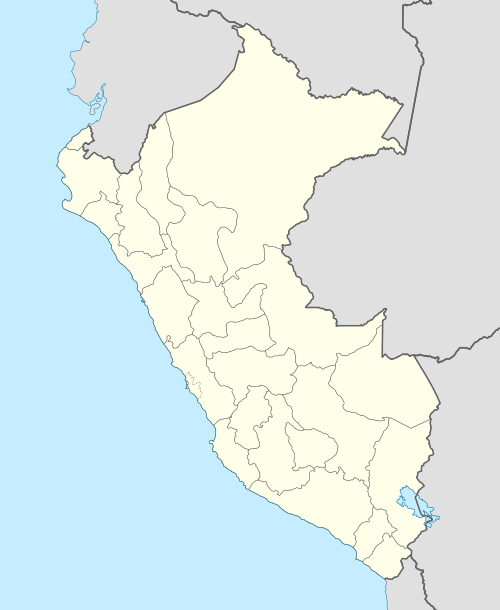Qhapiya
| Qhapiya | |
|---|---|
 View of Copacabana with Qhapiya (center-rght) and Asiru Phat'jata (on the right) in the background | |
| Highest point | |
| Elevation | 4,809 m (15,778 ft) [1] |
| Coordinates | 16°19′52.3″S 69°08′32.2″W / 16.331194°S 69.142278°WCoordinates: 16°19′52.3″S 69°08′32.2″W / 16.331194°S 69.142278°W [2] |
| Geography | |
 Qhapiya Peru | |
| Location | Peru, Puno Region |
Qhapiya (in the Aymara spelling)[3][4] or Qapiya (Uru language,[5] Hispanicized spellings Capía, Ccapia, Ccapía, Khapia, Khapía, K'apía) is a mountain in Peru, possibly an extinct volcano,[6] situated at a height of about 4,809 metres (15,778 ft). It is located in the Puno Region, Chucuito Province, in the districts Pomata and Zepita, and in the Yunguyo Province, in the districts Cuturapi, Copani and Yunguyo.[1][7] The mountain lies near Lake Titicaca at the road which connects Yunguyo and Puno, south of the hill Asiru Phat'jata.
In 2011 Qhapiya with its prehispanic archaeological site was declared a National Cultural Heritage (Patrimonio Cultural) of Peru by resolution No. 589-2011-VMPCIC-MC of May 13, 2011, of the Vice Minister of the Ministry of Culture[7] and a "Landscape Reserve" (Zona de Reserva Paisajística in Spanish) by Decrete Supreme No. 008-2011-MINAM.[8]
By the local people the mountain is venerated as an Apu.
Gallery
 Satellite view of Wiñaymarka Lake, the southern sub-basin of Lake Titicaca, and the mountain Qhapiya (on the left)
Satellite view of Wiñaymarka Lake, the southern sub-basin of Lake Titicaca, and the mountain Qhapiya (on the left)
References
- 1 2 mincetur.gob.pe Archived February 18, 2014, at the Wayback Machine. "Cerro "Apu" Khapia", retrieved on January 30, 2014
- ↑ mapcarta.com "Cerro Ccapia", retrieved on January 30, 2014
- ↑ Yatiqirinaka Aru Pirwa, Lima, 2005 (Aymara-Spanish dictionary): Qhapiya achachilaruxa luqapxiwa. (Aymara) - Rinden culto al espíritu ancestral de Ccapia. (Spanish)
- ↑ biblio.perueduca.edu.pe Archived February 2, 2014, at the Wayback Machine.: "Qhapiya"
- ↑ illa-a.org Katja Hannss, Vocabulario Uru (Uchumataqu), 2013
- ↑ geodeg.com "K'apía"
- 1 2 cepes.org.pe DECRETO SUPREMO Nº 008-2011-MINAM
- ↑ regionpuno.gob.pe Archived February 3, 2014, at the Wayback Machine. (archive)